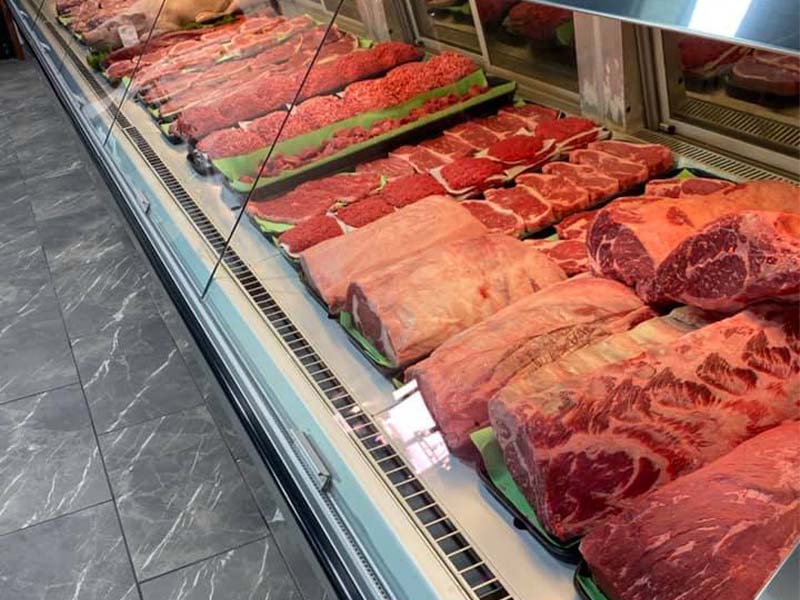What Makes Bagley Farms Meat Market Edwardsville IL Attract Attention for Meat Lovers
Reveal the Art of the Butcher's Cut in a Modern Meat Market
In the ever-evolving landscape of modern-day meat markets, the butcher's cut has actually transcended its standard roots, combining olden workmanship with contemporary methods. What genuinely sets the modern butcher apart is their capacity to create a much deeper connection between consumers and the origins of their meat.
Advancement of Butchery Techniques
The evolution of butchery techniques mirrors a rich tapestry of innovation and adaptation driven by advancements in technology, adjustments in customer demand, and a much deeper understanding of meat science. Historically, butchery was a craft passed down through generations, with approaches developed over centuries to take full advantage of return and flavor. Nevertheless, the industrial transformation ushered in mechanization, transforming conventional techniques and enabling massive processing.
The mid-20th century saw butchery strategies better improved by scientific insights into muscular tissue biology and meat aging, boosting both inflammation and preference. Technologies like vacuum product packaging and refrigeration expanded product shelf-life, enabling butchers to expand offerings and boost quality control. This duration also marked the increase of specific equipment, such as band saws and meat slicers, which enhanced accuracy and efficiency in meat processing.

Computerized systems currently help in monitoring pet provenance and enhancing cuts to meet details client preferences. Furthermore, a revival in artisanal butchery has actually emerged, mixing typical skills with modern understanding to cater to consumers seeking ethical and lasting meat choices.
Comprehending Meat Cuts
Recognizing the ins and outs of meat cuts is crucial for both butchers and consumers looking for top quality and worth. Each cut originates from a different part of the animal, presenting special tastes, structures, and cooking techniques - bagley farms meat market edwardsville il. Proficiency of these distinctions not only enhances culinary experiences but additionally maximizes the utility of each carcass. For butchers, precise cuts mirror skill and regard for the craft, making certain minimal waste and optimal return.

Recognizing muscle mass make-up is important; muscular tissues utilized more often by the animal have a tendency to be tougher and are best suited for slow food preparation techniques, while less-used muscular tissues, like those discovered in the loin, are extra tender and ideal for barbecuing or roasting. Experience with these differences empowers consumers to make informed options, boosting their cooking undertakings.
Choosing Top Quality Meat
Selecting the appropriate meat involves more than simply selecting a visually appealing item from the display. The art of selecting quality meat needs a critical eye and expertise of particular features that signify freshness and excellence.
Second of all, consider the marbling, which describes the white streaks of fat within the muscle. Proper marbling is a crucial indication of inflammation and taste, as it thaws throughout food preparation, boosting the meat's juiciness. Remember, higher marbling typically associates with superior high quality cuts, such as USDA Prime.
Appearance is one more critical aspect; meat ought to really feel solid to the touch, not slimed or extremely soft. Furthermore, be mindful of the aroma. Fresh meat needs to have a tidy, neutral odor, cost-free from any kind of sour or repulsive smells.
Coupling Cuts With Food Preparation Approaches

Conversely, tougher cuts like brisket and chuck roast are rich in collagen, which damages down right into gelatin when cooked slowly. These cuts are perfect for braising you could try these out or slow-moving roasting, enabling the meat to soften over time and establish deep, intricate flavors. Cuts such as short ribs and pork shoulder fare well with slow-cooking approaches, where expanded cooking times change their robust appearances right into succulent meals.
Lamb shanks and oxtail, which need long term food preparation to tenderize, are best prospects for stewing or slow simmering. These methods coax out abundant, hearty flavors while preserving wetness. By understanding the distinct attributes of each cut, chefs and home chefs alike can elevate their cooking productions, making sure each recipe is both satisfying and unforgettable.
The Butcher's Role Today
Navigating the progressing landscape of the contemporary meat market, the butcher's role today extends beyond mere preparation of cuts. Contemporary butchers are cooking craftsmens, teachers, and supporters for lasting practices. They link the space in between the farm and the fork by ensuring ethical sourcing, understanding animal husbandry, and prioritizing openness in the supply chain. This shift mirrors the expanding consumer need for high quality over amount, where provenance and pet welfare are extremely important.
In enhancement to crafting precise cuts, butchers currently involve directly with customers, providing cooking suggestions and customizing i was reading this choices to match specific requirements and choices. Their experience in meat aging, marbling, and flavor accounts equips customers to make educated choices, enhancing their culinary experiences. This individualized service exemplifies the butcher's progressing duty as a trusted advisor in the kitchen area.
Additionally, butchers are critical in lessening waste, using entire pets to develop diverse items such as sausages and supplies. This thorough technique not just respects the animal yet likewise lines up with contemporary sustainability objectives. In this way, the modern-day butcher personifies both tradition and innovation, adapting to an ever-changing market while protecting the artistry and integrity of their craft.
Verdict
Mastery in understanding diverse meat cuts and high quality signs equips butchers to provide enlightened recommendations, straightening specific cuts with optimum cooking approaches. By recognizing historic practices while accepting modern needs, the butcher's function remains crucial in today's advanced meat market.